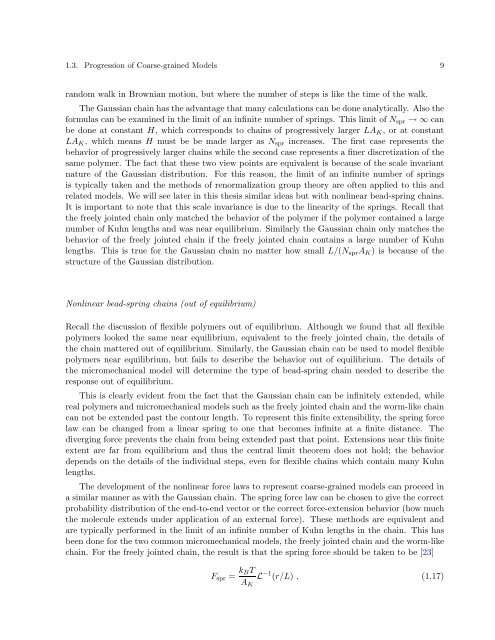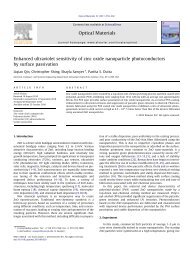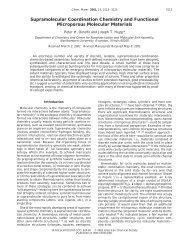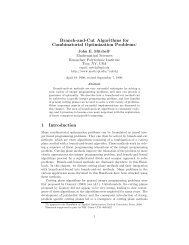Systematic development of coarse-grained polymer models Patrick ...
Systematic development of coarse-grained polymer models Patrick ...
Systematic development of coarse-grained polymer models Patrick ...
You also want an ePaper? Increase the reach of your titles
YUMPU automatically turns print PDFs into web optimized ePapers that Google loves.
1.3. Progression <strong>of</strong> Coarse-<strong>grained</strong> Models 9<br />
random walk in Brownian motion, but where the number <strong>of</strong> steps is like the time <strong>of</strong> the walk.<br />
The Gaussian chain has the advantage that many calculations can be done analytically. Also the<br />
formulas can be examined in the limit <strong>of</strong> an infinite number <strong>of</strong> springs. This limit <strong>of</strong> Nspr →∞can<br />
be done at constant H, which corresponds to chains <strong>of</strong> progressively larger LAK, or at constant<br />
LAK, which means H must be be made larger as Nspr increases. The first case represents the<br />
behavior <strong>of</strong> progressively larger chains while the second case represents a finer discretization <strong>of</strong> the<br />
same <strong>polymer</strong>. The fact that these two view points are equivalent is because <strong>of</strong> the scale invariant<br />
nature <strong>of</strong> the Gaussian distribution. For this reason, the limit <strong>of</strong> an infinite number <strong>of</strong> springs<br />
is typically taken and the methods <strong>of</strong> renormalization group theory are <strong>of</strong>ten applied to this and<br />
related <strong>models</strong>. We will see later in this thesis similar ideas but with nonlinear bead-spring chains.<br />
It is important to note that this scale invariance is due to the linearity <strong>of</strong> the springs. Recall that<br />
the freely jointed chain only matched the behavior <strong>of</strong> the <strong>polymer</strong> if the <strong>polymer</strong> contained a large<br />
number <strong>of</strong> Kuhn lengths and was near equilibrium. Similarly the Gaussian chain only matches the<br />
behavior <strong>of</strong> the freely jointed chain if the freely jointed chain contains a large number <strong>of</strong> Kuhn<br />
lengths. This is true for the Gaussian chain no matter how small L/(NsprAK) is because <strong>of</strong> the<br />
structure <strong>of</strong> the Gaussian distribution.<br />
Nonlinear bead-spring chains (out <strong>of</strong> equilibrium)<br />
Recall the discussion <strong>of</strong> flexible <strong>polymer</strong>s out <strong>of</strong> equilibrium. Although we found that all flexible<br />
<strong>polymer</strong>s looked the same near equilibrium, equivalent to the freely jointed chain, the details <strong>of</strong><br />
the chain mattered out <strong>of</strong> equilibrium. Similarly, the Gaussian chain can be used to model flexible<br />
<strong>polymer</strong>s near equilibrium, but fails to describe the behavior out <strong>of</strong> equilibrium. The details <strong>of</strong><br />
the micromechanical model will determine the type <strong>of</strong> bead-spring chain needed to describe the<br />
response out <strong>of</strong> equilibrium.<br />
This is clearly evident from the fact that the Gaussian chain can be infinitely extended, while<br />
real <strong>polymer</strong>s and micromechanical <strong>models</strong> such as the freely jointed chain and the worm-like chain<br />
can not be extended past the contour length. To represent this finite extensibility, the spring force<br />
law can be changed from a linear spring to one that becomes infinite at a finite distance. The<br />
diverging force prevents the chain from being extended past that point. Extensions near this finite<br />
extent are far from equilibrium and thus the central limit theorem does not hold; the behavior<br />
depends on the details <strong>of</strong> the individual steps, even for flexible chains which contain many Kuhn<br />
lengths.<br />
The <strong>development</strong> <strong>of</strong> the nonlinear force laws to represent <strong>coarse</strong>-<strong>grained</strong> <strong>models</strong> can proceed in<br />
a similar manner as with the Gaussian chain. The spring force law can be chosen to give the correct<br />
probability distribution <strong>of</strong> the end-to-end vector or the correct force-extension behavior (how much<br />
the molecule extends under application <strong>of</strong> an external force). These methods are equivalent and<br />
are typically performed in the limit <strong>of</strong> an infinite number <strong>of</strong> Kuhn lengths in the chain. This has<br />
been done for the two common micromechanical <strong>models</strong>, the freely jointed chain and the worm-like<br />
chain. For the freely jointed chain, the result is that the spring force should be taken to be [23]<br />
Fspr = kBT<br />
L −1 (r/L) , (1.17)<br />
AK







